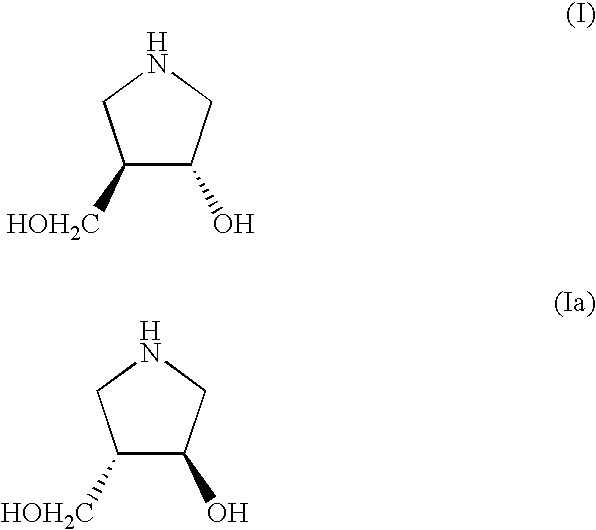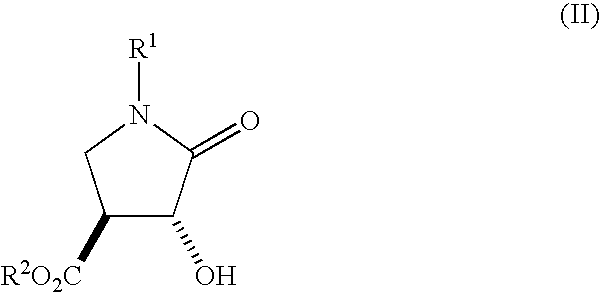Method for Preparing 3-Hydroxy-4-Hydroxymethyl-Pyrrolidine Compounds
a technology of pyrrolidine and hydroxymethyl, which is applied in the field of preparing 3hydroxy4hydroxymethylpyrrolidine compounds, can solve the problems of low product yield, complex synthetic procedures, and large reaction steps, and achieves low product yield
- Summary
- Abstract
- Description
- Claims
- Application Information
AI Technical Summary
Benefits of technology
Problems solved by technology
Method used
Image
Examples
example 1
(±)-2-N-Benzyl-isoxazolidine-4,5-cis-dicarboxylic acid diethyl ester [(±)-4]
[0082]N-Benzylhydroxylamine hydrochloride (144.8 g, 0.91 mol) and anhydrous sodium acetate (82 g, 1 mol) were stirred together in ethanol (800 mL) at ambient temperature for 30 minutes after which time 37% aqueous formaldehyde (134 mL, 1.8 mol) was added and stirring was continued for 1 hour. Diethyl maleate 3 (134 mL, 0.83 mol) was added and the mixture stirred for 1 h followed by heating under reflux for 2 h. After cooling, the mixture was filtered, the filtrate evaporated and the residue taken up in ethyl acetate (1.5 L) and washed three times with saturated sodium bicarbonate (200 mL each). The organic layer was removed and dried (MgSO4) and the solvent evaporated to give the crude product (±)-4 as a yellow oil (250.3 g, 98% based on amount of diethyl maleate). A small amount was purified by column chromatography on silica (eluent: EtOAc:hexanes, 2:8 v / v) and the analytical data is as follows: 1H NMR (CD...
example 2
(±)-trans-1-N-Benzyl-3-hydroxy-2-pyrrolidinone-4-carboxylic acid ethyl ester [(±)-5)]
[0083]To a solution of crude 2-N-benzyl-isoxazolidine-4,5-cis-dicarboxylic acid diethyl ester (±)-4 (250.3 g, 0.81 mol) in acetic acid (2 L) was added in one portion powdered zinc (106 g, 1.62 mol). An ice-water bath was used for a few minutes to control the very mild exotherm. The mixture was stirred for 15 minutes then filtered through Celite. The solvent was evaporated, the residue taken up in dichloromethane (1.5 L) and washed with 300 mL batches of a saturated solution of sodium bicarbonate until no more degassing was observed. The organic layer was removed and dried (MgSO4) and the solvent evaporated to give the crude product (±)-5 as a light brown oil (193.6 g, 91%). A small amount was purified by column chromatography on silica (eluent: ethyl acetate:hexanes, 1:1 v / v) and the analytical data is as follows: M.p. 65-66° C. (ethyl acetate-hexanes), Lit. 62-63.5° C. 1H NMR (CDCl3) δ ppm: 7.38-7....
example 3
(3R,4S)-1-N-Benzyl-3-hydroxy-2-pyrrolidinone-4-carboxylic acid [(+)-6] and (3S,4R)-1-N-Benzyl-3-hydroxy-2-pyrrolidinone-4-carboxylic acid ethyl ester [(−)-5]
[0084]A suspension of crude ester (±)-5 (191.8 g, 0.72 mol) in potassium phosphate buffer (0.1 M, 0.1 M NaCl, pH 7.5, 10 L) was stirred over Novozyme® 435 (20.0 g) for 5 h at 25° C. The enzyme was removed by filtration and the filtrate saturated with sodium chloride. Unreacted ester (−)-5 was removed by extraction with chloroform (3×5 L). The aqueous mixture was then brought to pH 1 with HCl (6 N) and further extracted with chloroform (9×5 L). The aqueous phase was then extracted with half the volume of EtOAc. The combined extracts were dried (MgSO4) and concentrated under reduced pressure to give the crude title compound (+)-6 as a light brown solid (66.7 g, 39%). The analytical data for (+)-6 (yield: 1.78 mmol, 44%) and (−)-5 (yield: 1.85 mmol, 46%) derived from the enzymatic hydrolysis of a small batch (3.95 mmol) of chromato...
PUM
| Property | Measurement | Unit |
|---|---|---|
| enantiomeric excess | aaaaa | aaaaa |
| enantiomeric excess | aaaaa | aaaaa |
| pH | aaaaa | aaaaa |
Abstract
Description
Claims
Application Information
 Login to View More
Login to View More - R&D
- Intellectual Property
- Life Sciences
- Materials
- Tech Scout
- Unparalleled Data Quality
- Higher Quality Content
- 60% Fewer Hallucinations
Browse by: Latest US Patents, China's latest patents, Technical Efficacy Thesaurus, Application Domain, Technology Topic, Popular Technical Reports.
© 2025 PatSnap. All rights reserved.Legal|Privacy policy|Modern Slavery Act Transparency Statement|Sitemap|About US| Contact US: help@patsnap.com



